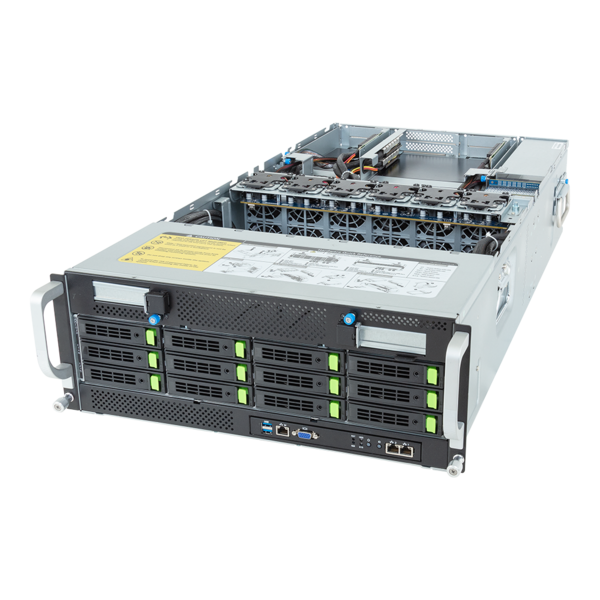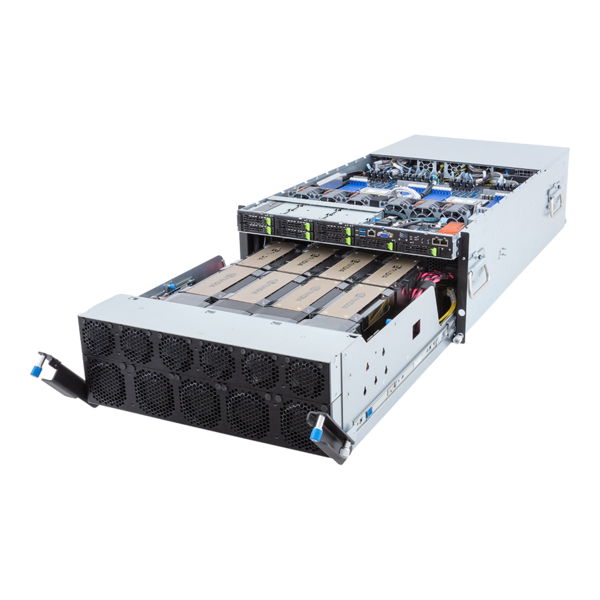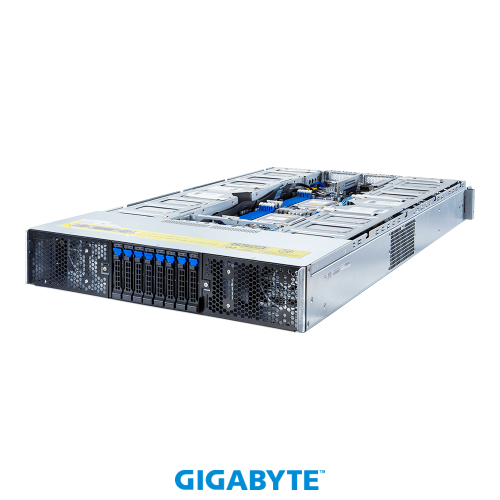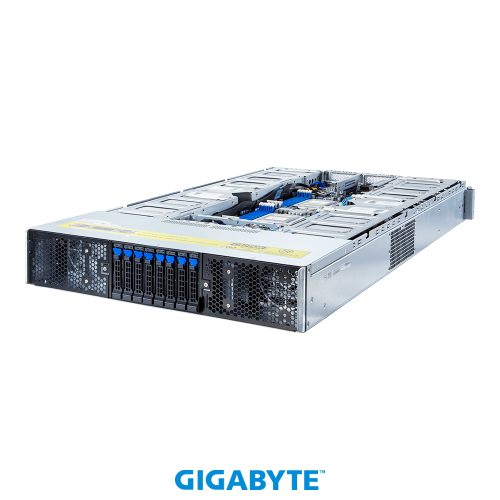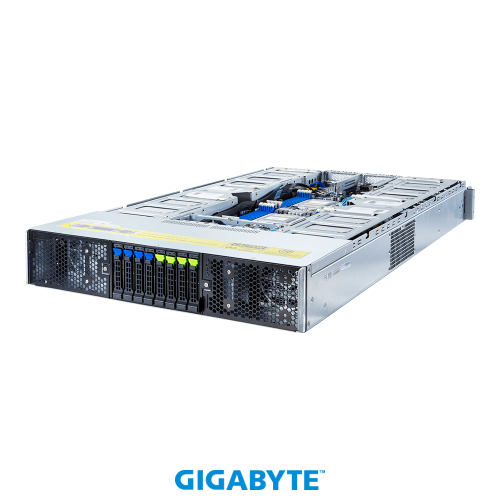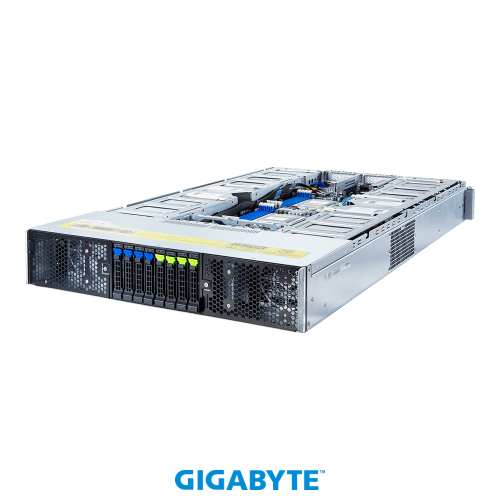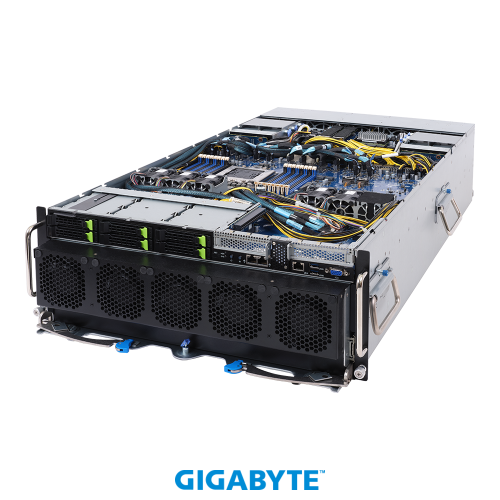GIGABYTE G152-Z12 (rev. 200)
Application: AI Platform
- Immersion Cooling Server
- Supports up to 2 x Dual slot Gen4 GPUs
- Single AMD EPYC™ 7003/7002 Series Processors
- 8-Channel DDR4 RDIMM/LRDIMM, 8 x DIMMs
- 2 x 10Gb/s LAN ports via Intel® X550-AT2
- 4 x 2.5" Gen4 NVMe internal bays
- 2 x FHFL PCIe Gen4 x16 slots for GPUs
- 2 x LP PCIe Gen4 x16 slots
- Dual 2000W 80 PLUS Platinum redundant power supply
GIGABYTE G152-Z12 (rev. 200)
Servers Designed for Single-Phase Immersion Cooling
Unlike air cooling, servers used in single-phase immersion cooling have some special considerations:
- Server installation mechanism
- Chemical phase changes
- Steady flow of coolant in the system
By partnering with the major single-phase immersion cooling suppliers in the market, GIGABYTE's single-phase immersion cooling servers can be installed directly in their off-the-shelf tanks from these partners, eliminating the need for product compatibility testing and customization. These systematic modifications greatly reduce the time for verification and adoption of single-phase immersion cooling technology.
Structural Integrity and Simplified Management
Servers must be installed vertically in the tank, and this lowering or raising of servers is due to an optimized tank design for single-phase immersion cooling. Therefore, the server installed upright needs to have rigid and firm structural integrity to ensure the chassis will not deform. Also, due to the vertical design, the cable routing and maintenance are also different than traditional data centers. Therefore, we re-examine the design and strengthen the server chassis for immersion cooling and reroute the cables. For instance, I/O ports are all arranged on the rear side facing up, and the network cables need to be rerouted to the sides so that maintenance can be quick and easy. Also, to make it more convenient for IT to install or remove a server, a bracket was added to allow hooks to move the server.
Design to Ensure Steady Fluid Flow in the Tank
When a server is submerged in a coolant, an important condition is that the fluid is circulated well, and the warm fluid is pumped out as cooler fluid is pumped in. Only by maintaining a stable coolant flow can the heat absorbed by the fluid be managed, and the system can automatically adjust the coolant flow rate according to the operation needs. To ensure efficient heat removal, the server design for single-phase immersion cooling not only must remove any components that negatively affect the fluid flow in the system, but they also must reduce the dead space in the chassis to avoid heat accumulation. Based on the viscosity of the coolant and the specific heat capacity of the coolant, the heat dissipation rate of the server must be constantly monitored and adjusted to avoid issues . Servers developed for single-phase immersion cooling can significantly reduce unnecessary barriers that users may encounter when adopting new technologies, allowing them to focus on productivity.
Made with Materials Suitable for Various Coolants
Single-phase immersion cooling submerges the server in a cooling fluid that removes heat by directly coming into contact with the heating elements. GIGABYTE had to evaluate how the chemical composition of the coolant may affect the components as well as the effect of the temperature and process on the coolant. Through theory and experimental experience, we perfected the design and will continue to explore materials that are suitable for immersion cooling.
G152-Z12 Product Overview
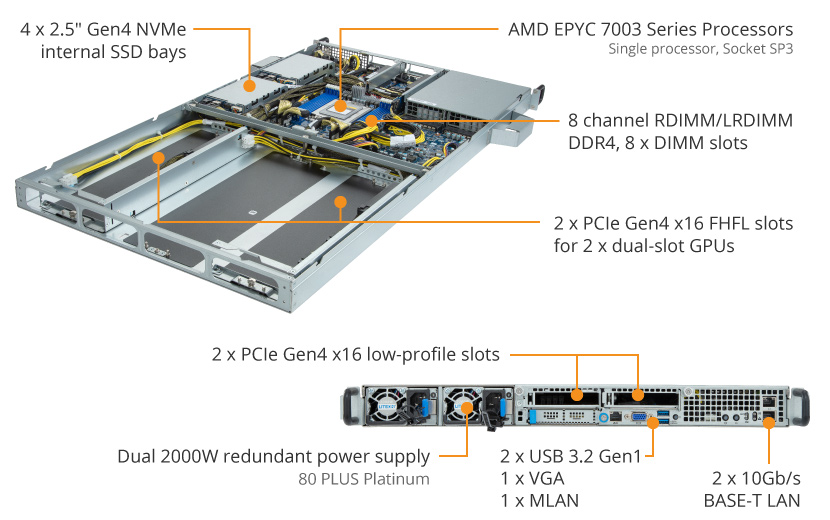
G152-Z12 Block Diagram
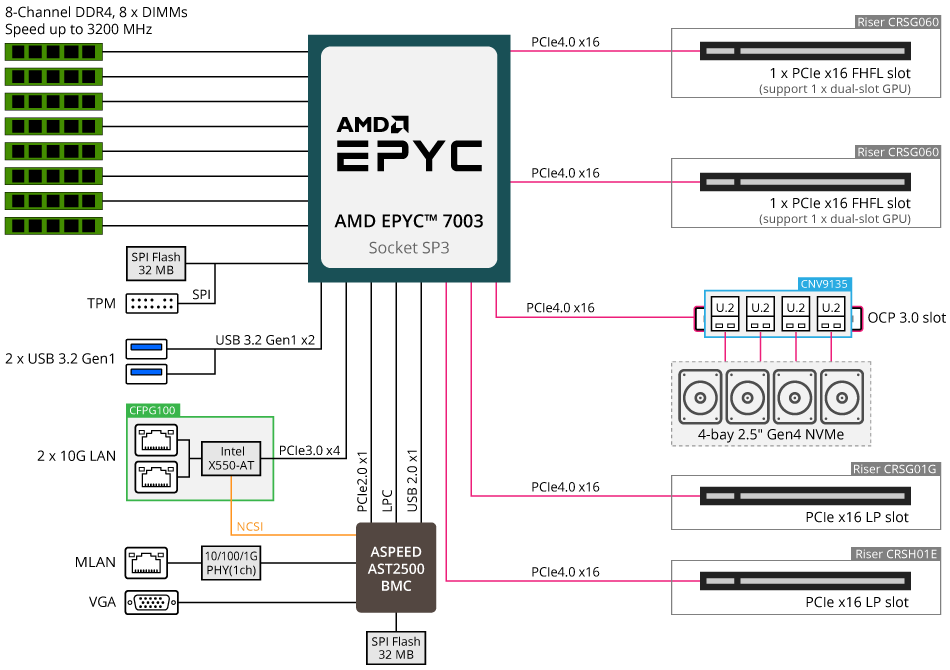
Architecture for Modern Data Centers
AMD EPYC™ 7003 Series Processors
GIGABYTE servers and AMD EPYC 7003 Series Processors deliver the highest possible I/O throughput to pave the way for fast communication between CPU and accelerator in HPC and data analytics.
- Up to 64 Cores
- 8 Channels of DDR4-3200
- Up to 4TB Memory Capacity
- 128 lanes PCIe 4.0
- 2-way SMT & Turbo Boost
- 4,6,8-channel Memory Interleave
- Synchronized Fabric and Memory Clock Speeds
- Secure Memory Encryption
- Secure Encrypted Virtualization
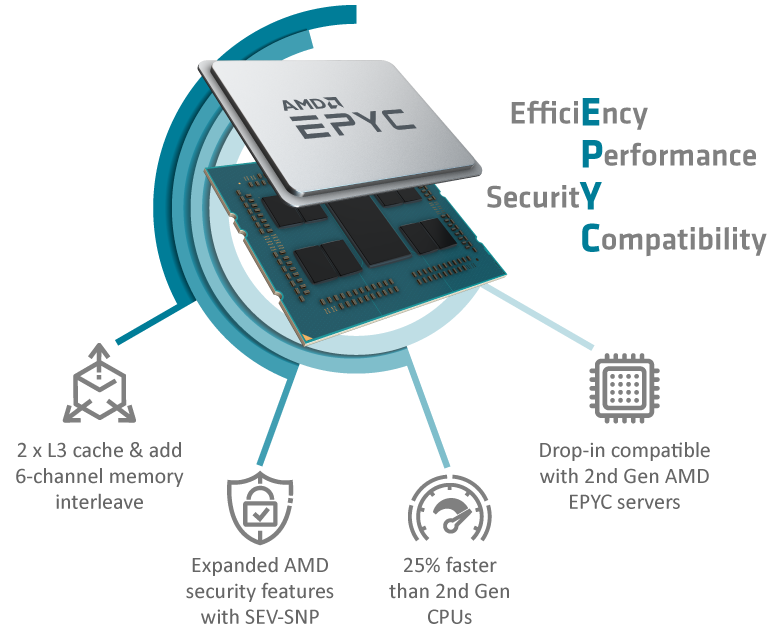
Hardware Security
Optional TPM 2.0 Module
For hardware-based authentication, the passwords, encryption keys, and digital certificates are stored in a TPM module to prevent unwanted users from gaining access to your data. GIGABYTE TPM modules come in either a Serial Peripheral Interface or Low Pin Count bus.
.png)
High Availability
Smart Crises Management and Protection (SCMP)
SCMP is a GIGABYTE patented feature which is deployed in servers with non-fully redundant PSU design. With SCMP, in the event of faulty PSU or overheated system, the system will force the CPU into an ultra-low power mode that reduces the power load, which prevents the system from unexpected shutdown and avoids component damage or data loss.

Smart Ride Through (SmaRT)
To prevent server downtime and data loss as a result of loss of AC power, GIGABYTE implements SmaRT in all our server platforms. When such an event occurs, the system will throttle while maintaining availability and reducing power load. Capacitors within the power supply can supply power for 10-20ms, which is enough time to transition to a backup power source for continued operation.

User Friendly
Certified Ready with Software Partners
Being a member of key software alliance partner programs enables GIGABYTE to rapidly develop and validate joint solutions, enabling our customers to modernize their data centers and implement IT infrastructure and application services with speed, agility, and cost optimization.

Tool-less Drive Bays Design
Clipping mechanism secures the drive in place. Install or replace a new drive in seconds.
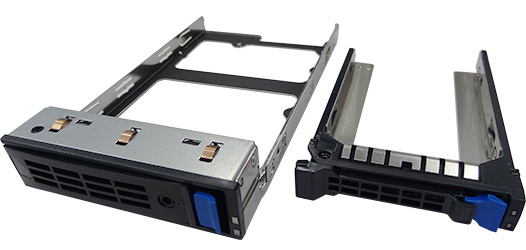
Value-added Management
GIGABYTE offers free-of-charge management applications via a specialized small processor built on the server.
GIGABYTE Management Console
For management and maintenance of a server or a small cluster, users can use the GIGABYTE Management Console, which is pre-installed on each server. Once the servers are running, IT staff can perform real-time health monitoring and management on each server through the browser-based graphical user interface. In addition, the GIGABYTE Management Console also provides:
- Support for standard IPMI specifications that allows users to integrate services into a single platform through an open interface
- Automatic event recording, which can record system behavior 30 seconds before an event occurs, making it easier to determine subsequent actions
- Integrate SAS/SATA/NVMe devices and RAID controller firmware into GIGABYTE Management Console to monitor and control Broadcom® MegaRAID adapters.
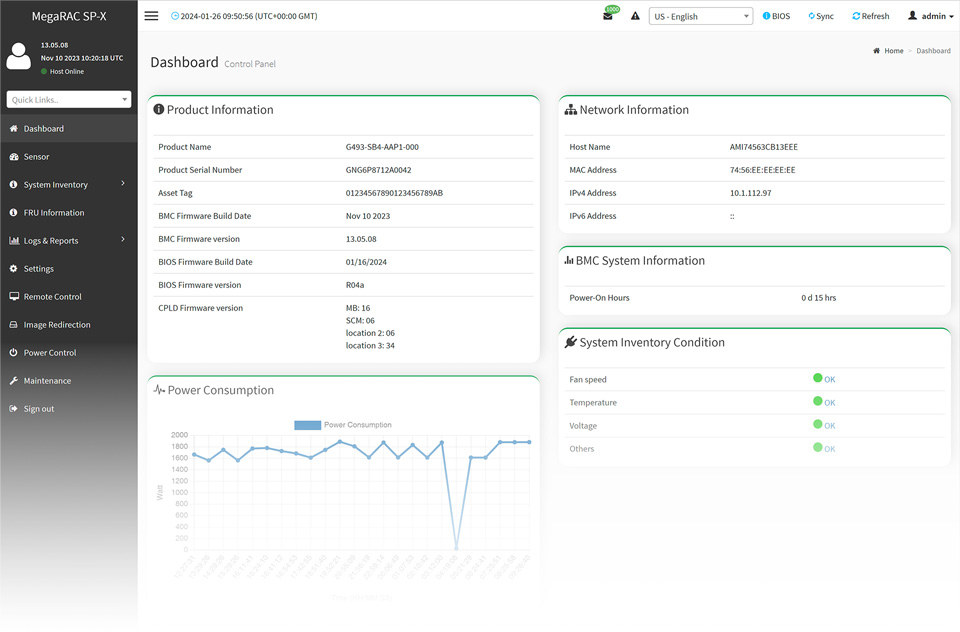
GIGABYTE Server Management (GSM)
GSM is a software suite that can manage clusters of servers simultaneously over the internet. GSM can be run on all GIGABYTE servers and has support for Windows and Linux. GSM can be downloaded from GIGABYTE website and complies with IPMI and Redfish standards. GSM includes a complete range of system management functions that includes the following utilities:
- GSM Server: A software program that provides real-time, remote control using a graphical user interface through an administrator’s computer or through a server in the cluster. The software allows ease of maintenance for large clusters of servers.
- GSM CLI: A command-line interface for monitoring and managing remotely.
- GSM Agent: A software program installed on each GIGABYTE server node that retrieves information from each system and devices through the OS, and this software integrates with GSM Server or GSM CLI.
- GSM Mobile: A mobile app for both Android and iOS that provides admins with real-time system information.
- GSM Plugin: An application program interface that allows users to use VMware vCenter for real-time monitoring and management of server clusters.
.png)
GIGABYTE G152-Z12 (rev. 200) – In-Depth Review & Buyer’s Guide
The GIGABYTE G152-Z12 (rev. 200) is a dual-socket server motherboard designed for AMD EPYC 9004 "Genoa" processors, making it a powerhouse for data centers, cloud computing, AI, and HPC workloads. Below is a comprehensive review to help you decide if this is the right motherboard for your needs.
🔍 Key Specifications
✅ CPU Support: Dual AMD EPYC 9004 (Zen 4, up to 96 cores per CPU, 192 cores total)
✅ Memory: 24 × DDR5 DIMM slots (12 per CPU, up to 6TB with 256GB LRDIMMs, 4800MHz+ support)
✅ PCIe Expansion:
- 7 × PCIe 5.0 x16 slots (supports x16/x8/x4 bifurcation)
- 1 × PCIe 5.0 x8 slot (via riser)
✅ Storage:
- 8 × SATA 6Gbps
- 2 × M.2 (PCIe 5.0 x4)
- Optional U.2/U.3 NVMe support
✅ Networking:
- 2 × 1GbE (Intel i350-AM4)
- OCP 3.0 mezzanine slot (for 10/25/100/200GbE)
✅ Management: ASPEED AST2600 BMC (IPMI 2.0, Redfish API)
✅ Form Factor: EEB (12" × 13")
🔥 Performance & Strengths
1. Unmatched CPU Power (Dual EPYC 9004, Zen 4)
- Supports up to 192 cores / 384 threads (96-core EPYC 9654/9684X).
- PCIe 5.0 doubles bandwidth over PCIe 4.0 (crucial for AI/ML, GPU computing, and NVMe storage).
- Higher IPC & efficiency than previous-gen EPYC 7003 (Zen 3).
2. Massive DDR5 Memory Capacity
- 24 DIMM slots (12 per CPU) with DDR5-4800+ support.
- Up to 6TB RAM (with 256GB LRDIMMs), ideal for in-memory databases (Redis, SAP HANA).
3. Future-Proof PCIe 5.0 Expansion
- 7 × PCIe 5.0 x16 slots (great for GPUs, NVMe arrays, or high-speed networking).
- OCP 3.0 slot allows for 200GbE/400GbE networking without wasting PCIe slots.
4. Enhanced Storage Flexibility
- M.2 PCIe 5.0 x4 slots (faster than PCIe 4.0 SSDs).
- 8 × SATA + U.2/U.3 support for mixed storage setups.
5. Improved Remote Management (AST2600 BMC)
- HTML5 KVM (no Java required).
- Redfish API for automation.
- Better security with firmware TPM.
⚠️ Potential Drawbacks
❌ High Power Consumption
- Dual EPYC 9004 CPUs + DDR5 can draw 500W+ under load (requires high-efficiency PSU).
❌ No Onboard 10GbE/25GbE
- Requires OCP or PCIe NIC for high-speed networking.
❌ Limited PCIe Slot Spacing
- Some x16 slots may be blocked when using large GPUs.
❌ Expensive Platform
- EPYC 9004 CPUs + DDR5 memory are costly (budget buyers may prefer EPYC 7003).
🎯 Who Should Buy This Motherboard?
✔ Data Centers – High core density for virtualization & cloud hosting.
✔ AI/ML & HPC – PCIe 5.0 boosts GPU & NVMe performance.
✔ Enterprise Databases – 6TB RAM support for SAP, Oracle, SQL.
✔ High-Speed Networking – OCP 3.0 supports 200GbE/400GbE.
❌ Not Ideal For:
- Small businesses (overkill for basic servers).
- Budget builds (EPYC 7003 + DDR4 is cheaper).
The GIGABYTE G152-Z12 (rev. 200) is a beast of a server motherboard, offering unmatched CPU power, DDR5 memory, and PCIe 5.0 expansion for demanding workloads. While expensive and power-hungry, it’s a top-tier choice for data centers, AI, and HPC.
✅ Buy If:
- You need maximum cores & PCIe 5.0 bandwidth.
- You’re running memory-intensive workloads (6TB RAM support).
- Future-proofing for AI/ML, 200GbE networking, or NVMe storage.
❌ Avoid If:
- You’re on a budget (consider EPYC 7003 boards).
- You don’t need dual-socket or PCIe 5.0.
🔎 Need Alternatives?
- For Budget Builds: GIGABYTE H262-Z6B (EPYC 7003, DDR4).
- For Single-Socket: ASUS K16PA-U0 (EPYC 9004, 1P).
To purchase the GIGABYTE G152-Z12 (rev. 200) from VDO, the official distributor of Giga Computing and GigaIPC products in Vietnam, here is the detailed information you need to proceed:
- Website: https://dis.vdo.com.vn/
- Email: info@vdo.vn
- Phone: 1900 0366
VDO Distributor - Vietnam's Leading Technology Infrastructure ICT Distributor
Website: dis.vdo.com.vn
1900 0366
- Contact our call center or branch phone number to inquire
- Hà Nội: 024 7305 6666
- TP.HCM: 028 7308 6666
- Đà Nẵng: 093 610 8858






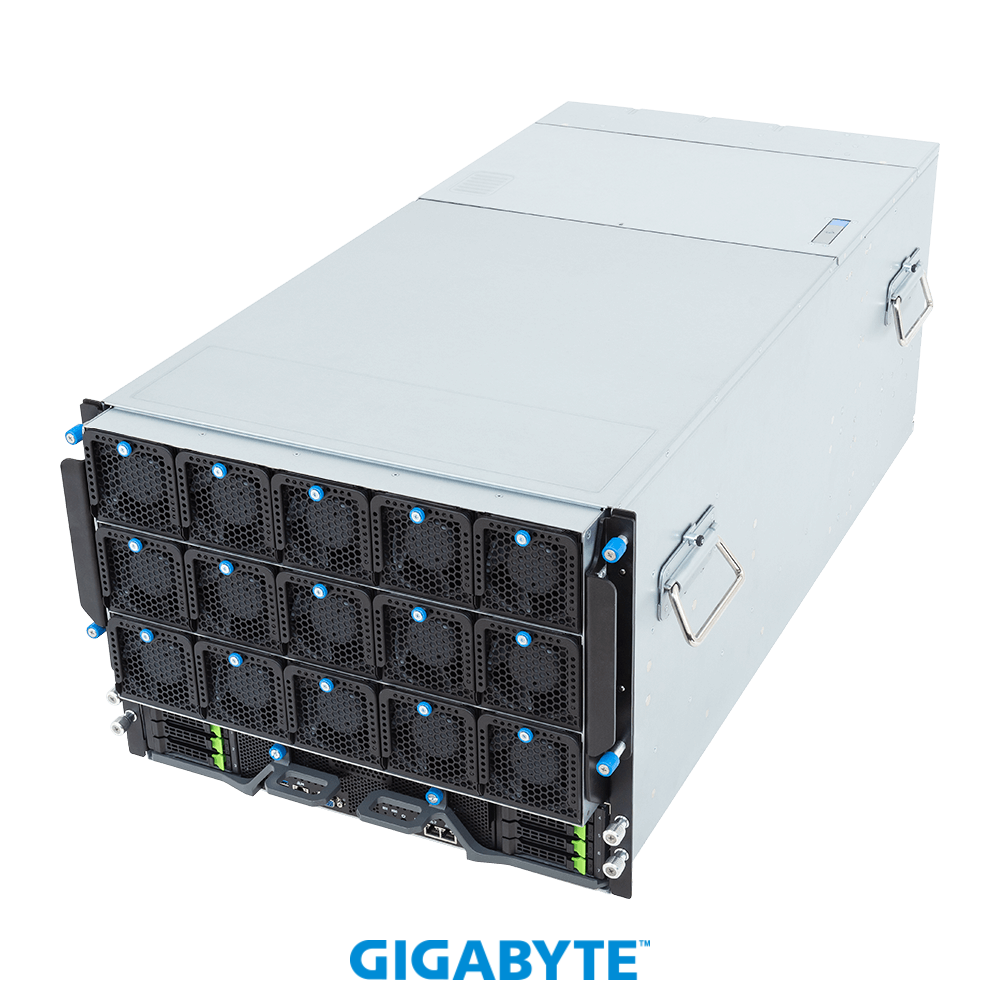
-a0ba42fc64722.png)
